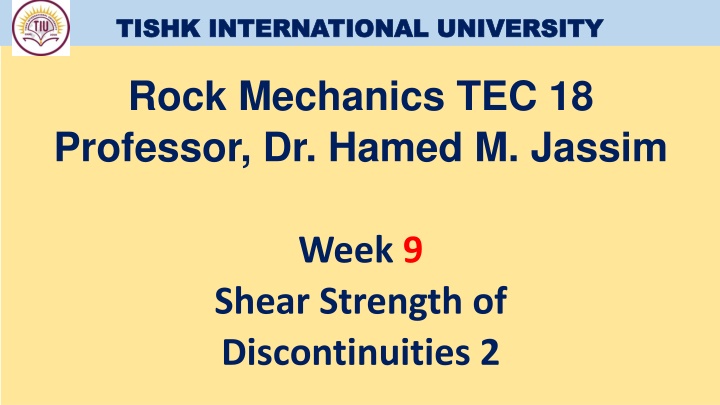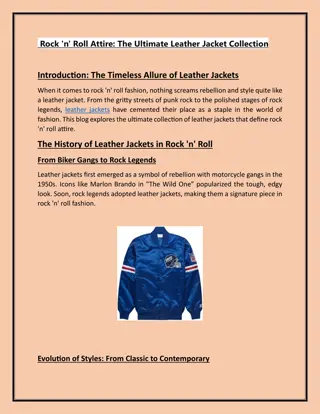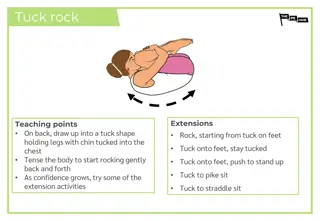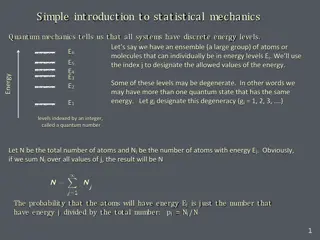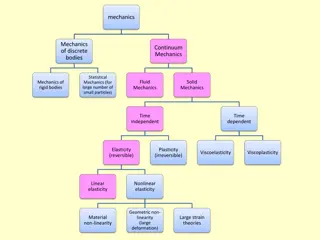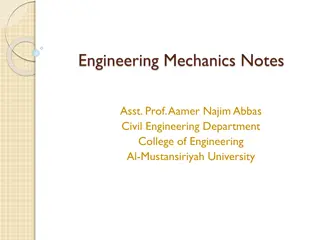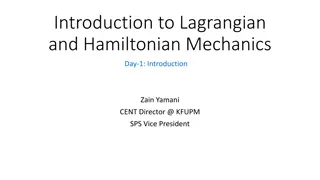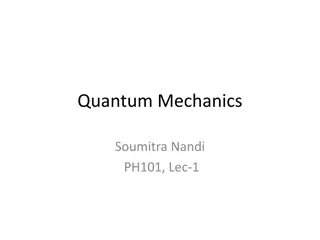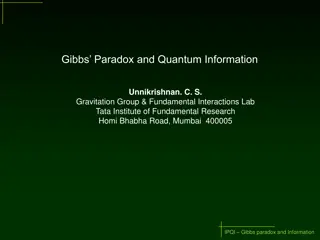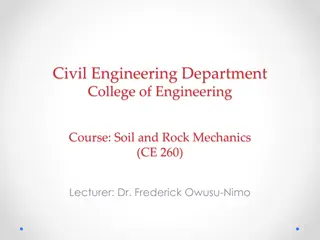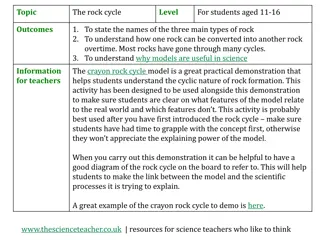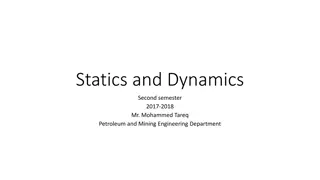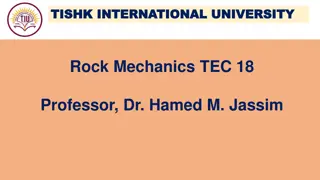Rock Mechanics TEC 18
TISHK INTERNATIONAL UNIVERSITY professor Dr. Hamed M. Jassim explores shear strength behavior of rock discontinuities. Discover Barton's estimate for shear strength and the non-linear strength criterion for rock joints developed by Barton and Choubey. Learn about joint roughness coefficients, compressive strength, and more in this insightful study.
Uploaded on Feb 19, 2025 | 0 Views
Download Presentation

Please find below an Image/Link to download the presentation.
The content on the website is provided AS IS for your information and personal use only. It may not be sold, licensed, or shared on other websites without obtaining consent from the author.If you encounter any issues during the download, it is possible that the publisher has removed the file from their server.
You are allowed to download the files provided on this website for personal or commercial use, subject to the condition that they are used lawfully. All files are the property of their respective owners.
The content on the website is provided AS IS for your information and personal use only. It may not be sold, licensed, or shared on other websites without obtaining consent from the author.
E N D
Presentation Transcript
TISHK INTERNATIONAL UNIVERSITY TISHK INTERNATIONAL UNIVERSITY Rock Mechanics TEC 18 Professor, Dr. Hamed M. Jassim Week 9 Shear Strength of Discontinuities 2
TISHK INTERNATIONAL UNIVERSITY TISHK INTERNATIONAL UNIVERSITY Barton s estimate of shear strength Equation (4) is valid at low normal stresses where shear displacement is due to sliding along the inclined surfaces. At higher normal stresses, the strength of the intact material will be exceeded and the teeth will tend to break off, resulting in a shear strength behaviour which is more closely related to the intact material strength than to the frictional characteristics of the surfaces.
TISHK INTERNATIONAL UNIVERSITY TISHK INTERNATIONAL UNIVERSITY While Patton s approach has the merit of being very simple, it does not reflect the reality that changes in shear strength with increasing normal stress are gradual rather than abrupt. Barton (1973, 1976) studied the behaviour of natural rock joints and proposed that equation (4) could be re-written as:
TISHK INTERNATIONAL UNIVERSITY TISHK INTERNATIONAL UNIVERSITY . (5) Where JRC is the joint roughness coefficient and JCS is the joint wall compressive strength
TISHK INTERNATIONAL UNIVERSITY TISHK INTERNATIONAL UNIVERSITY Barton developed his first non-linear strength criterion for rock joints; using the basic friction angle b from analysis of joint strength data reported in the literature. Barton and Choubey (1977), on the basis of their direct shear test results for 130 samples of variably weathered rock joints, revised this equation to:
TISHK INTERNATIONAL UNIVERSITY TISHK INTERNATIONAL UNIVERSITY Where r is the residual friction angle Barton and Choubey suggest that r can be estimated from
TISHK INTERNATIONAL UNIVERSITY TISHK INTERNATIONAL UNIVERSITY Where r is the Schmidt rebound number wet and weathered fracture surfaces, and R is the Schmidt rebound number on dry unweathered sawn surfaces.
TISHK INTERNATIONAL UNIVERSITY TISHK INTERNATIONAL UNIVERSITY Equations 6 and 7 have become part of the Barton-Bandis criterion for rock joint strength and deformability (Barton and Bandis, 1990).
TISHK INTERNATIONAL UNIVERSITY TISHK INTERNATIONAL UNIVERSITY Field estimates of JRC The joint roughness coefficient JRC is a number that can be estimated by comparing the appearance of a discontinuity surface with standard profiles published by Barton and others. One of the most useful of these profile sets was published by Barton and Choubey (1977) and is reproduced in Figure 5.
TISHK INTERNATIONAL UNIVERSITY TISHK INTERNATIONAL UNIVERSITY The joint roughness coefficient JRC is a number that can be estimated by comparing the appearance of a discontinuity surface with standard profiles published by Barton and others. One of the most useful of these profile sets was published by Barton and Choubey (1977) and is reproduced in Figure 5.
TISHK INTERNATIONAL UNIVERSITY TISHK INTERNATIONAL UNIVERSITY
TISHK INTERNATIONAL UNIVERSITY TISHK INTERNATIONAL UNIVERSITY
TISHK INTERNATIONAL UNIVERSITY TISHK INTERNATIONAL UNIVERSITY
TISHK INTERNATIONAL UNIVERSITY TISHK INTERNATIONAL UNIVERSITY The length of the Profile is 3 m and the Amplitude of the asperities is 2 mm Then JRC = 0.5
TISHK INTERNATIONAL UNIVERSITY TISHK INTERNATIONAL UNIVERSITY Shear strength of filled discontinuities The discussion presented in the previous sections has dealt with the shear strength of discontinuities in which rock wall contact occurs over the entire length of the surface under consideration. This shear strength can be reduced drastically when part or all of the surface is not in intimate contact, but covered by soft filling material such as clay gouge.
TISHK INTERNATIONAL UNIVERSITY TISHK INTERNATIONAL UNIVERSITY For planar surfaces, such as bedding planes in sedimentary rock, a thin clay coating will result in a significant shear strength reduction. For a rough or undulating joint, the filling thickness has to be greater than the amplitude of the undulations before the shear strength is reduced to that of the filling material.
TISHK INTERNATIONAL UNIVERSITY TISHK INTERNATIONAL UNIVERSITY A comprehensive review of the shear strength of filled discontinuities was prepared by Barton (1974) and a summary of the shear strengths of typical discontinuity fillings, based on Barton's review, is given in Table 1.
TISHK INTERNATIONAL UNIVERSITY TISHK INTERNATIONAL UNIVERSITY
TISHK INTERNATIONAL UNIVERSITY TISHK INTERNATIONAL UNIVERSITY
TISHK INTERNATIONAL UNIVERSITY TISHK INTERNATIONAL UNIVERSITY Where a significant thickness of clay or gouge fillings occurs in rock masses and where the shear strength of the filled discontinuities is likely to play an important role in the stability of the rock mass, it is strongly recommended that samples of the filling be sent to a soil mechanics laboratory for testing.
TISHK INTERNATIONAL UNIVERSITY TISHK INTERNATIONAL UNIVERSITY Influence of water pressure When water pressure is present in a rock mass, the surfaces of the discontinuities are forced apart and the normal stress n is reduced. Under steady state conditions, where there is sufficient time for the water pressures in the rock mass to reach equilibrium, the reduced normal stress is defined by:
TISHK INTERNATIONAL UNIVERSITY TISHK INTERNATIONAL UNIVERSITY n' = ( n - u) Where: u is the water pressure. The reduced normal stress n' is usually called the effective normal stress, and it can be used in place of the normal stress term n in all of the equations presented above.
TISHK INTERNATIONAL UNIVERSITY TISHK INTERNATIONAL UNIVERSITY Instantaneous cohesion and friction Due to the historical development of the subject of rock mechanics, many of the analyses, used to calculate factors of safety against sliding, are expressed in terms of the Mohr-Coulomb cohesion (c) and friction angle ( ), defined in Equation 1.
TISHK INTERNATIONAL UNIVERSITY TISHK INTERNATIONAL UNIVERSITY Since the 1970s it has been recognized that the relationship between shear strength and normal stress is more accurately represented by a non-linear relationship such as that proposed by Barton and Bandis (1990). However, because this relationship is not expressed in terms of c and , it is necessary to devise some means for estimating the equivalent cohesive strengths and angles of friction from relationships such as those proposed by Barton and Bandis.
TISHK INTERNATIONAL UNIVERSITY TISHK INTERNATIONAL UNIVERSITY Figure 8 gives definitions of the instantaneous cohesion ci and the instantaneous friction angle i for a normal stress of n . These quantities are given by the intercept and the inclination, respectively, of the tangent to the non-linear relationship between shear strength and normal stress.
TISHK INTERNATIONAL UNIVERSITY TISHK INTERNATIONAL UNIVERSITY
TISHK INTERNATIONAL UNIVERSITY TISHK INTERNATIONAL UNIVERSITY These quantities may be used for stability analyses in which the Mohr-Coulomb failure criterion (Equation 1) is applied, provided that the normal stress n is reasonably close to the value used to define the tangent point.
TISHK INTERNATIONAL UNIVERSITY TISHK INTERNATIONAL UNIVERSITY Note that equation 6 is not valid for n = 0 and it ceases to have any practical meaning for r + JRC log10 (JCS/ n ) > 700 This limit can be used to determine a minimum value for n . An upper limit for n is given by n = JCS.
TISHK INTERNATIONAL UNIVERSITY TISHK INTERNATIONAL UNIVERSITY In a typical practical application, a spreadsheet program can be used to solve Equation 6 and to calculate the instantaneous cohesion and friction values for a range of normal stress values. A portion of such a spreadsheet is illustrated in Figure 9. In this spreadsheet the instantaneous friction angle i, for a normal stress of n , has been calculated from the relationship:
TISHK INTERNATIONAL UNIVERSITY TISHK INTERNATIONAL UNIVERSITY The instantaneous cohesion ci is calculated from:
TISHK INTERNATIONAL UNIVERSITY TISHK INTERNATIONAL UNIVERSITY In choosing the values of ci and i for use in a particular application, the average normal stress n acting on the discontinuity planes should be estimated and used to determine the appropriate row in the spreadsheet. For many practical problems in the field, a single average value of n will suffice but, where critical stability problems are being considered, this selection should be made for each important discontinuity surface.
TISHK INTERNATIONAL UNIVERSITY TISHK INTERNATIONAL UNIVERSITY
TISHK INTERNATIONAL UNIVERSITY TISHK INTERNATIONAL UNIVERSITY In choosing the values of ci and i for use in a particular application, the average normal stress n acting on the discontinuity planes should be estimated and used to determine the appropriate row in the spreadsheet. For many practical problems in the field, a single average value of n will suffice but, where critical stability problems are being considered, this selection should be made for ach important discontinuity surface.
